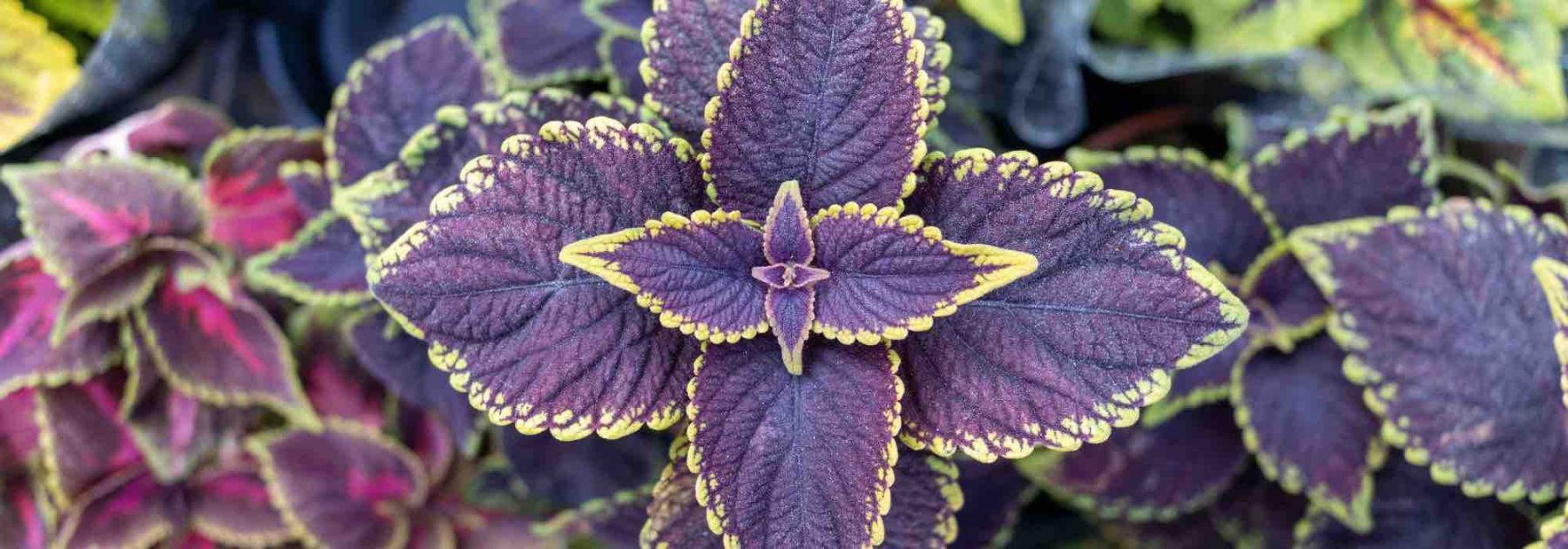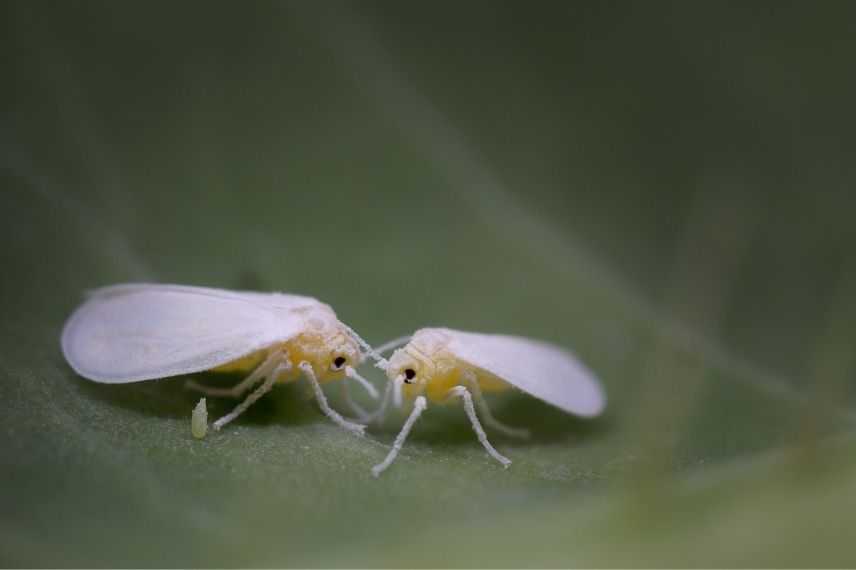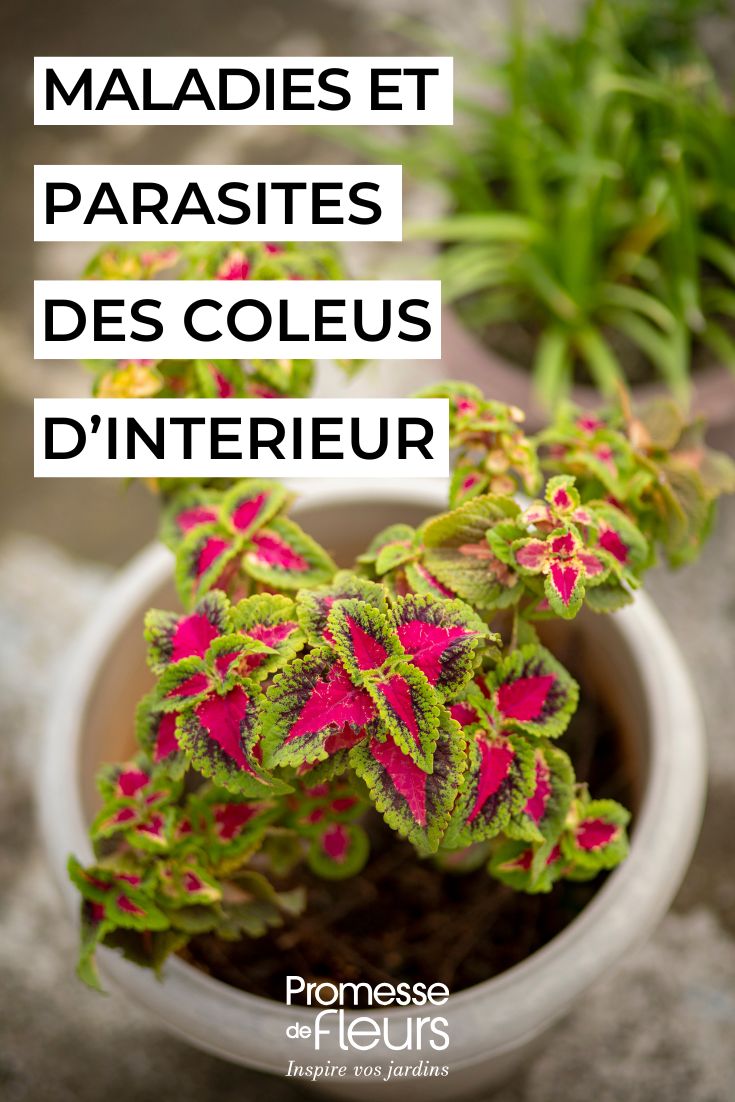
# Coleus Indoors: Preventing and Treating Diseases and Parasites Coleus (*Plectranthus scutellarioides*) is a popular houseplant prized for its vibrant foliage. While generally easy to care for, it can occasionally suffer from diseases and parasitic infestations. Here’s how to keep your Coleus healthy and thriving indoors. ## Common Diseases ### **Powdery Mildew** A white, powdery coating on leaves indicates powdery mildew, often caused by poor air circulation or high humidity. **Prevention & Treatment:** - Improve ventilation around the plant. - Avoid wetting the foliage when watering. - Apply a fungicide if necessary. ### **Root Rot** Overwatering leads to soggy soil, causing roots to rot. Symptoms include yellowing leaves and wilting. **Prevention & Treatment:** - Ensure proper drainage in the pot. - Water only when the top inch of soil is dry. - Trim affected roots and repot in fresh soil if rot is severe. ## Common Parasites ### **Spider Mites** Tiny, web-spinning pests that cause speckled, discoloured leaves. **Prevention & Treatment:** - Increase humidity (mites thrive in dry conditions). - Wipe leaves with a damp cloth. - Use insecticidal soap or neem oil. ### **Aphids** Small, sap-sucking insects that cluster on new growth, causing distorted leaves. **Prevention & Treatment:** - Spray with water to dislodge them. - Apply a mild soap solution or neem oil. ## General Care Tips - **Light:** Bright, indirect light maintains vibrant leaf colour. - **Watering:** Keep soil moist but not waterlogged. - **Humidity:** Moderate humidity helps prevent pests. By monitoring your Coleus and acting quickly at the first sign of trouble, you can enjoy its stunning foliage year-round! ????
for a healthy plant
Contents
Cherished for its vibrantly coloured leaves, Coleus (or Solenostemon scutellarioides) is increasingly gracing our interiors. Easy to grow and decorative, it is nevertheless sensitive to certain cultivation mistakes and parasitic issues common in confined environments. Yellowing leaves, weak growth, suspicious spots or invasive little critters… all warning signs not to be ignored.
In this article, discover the most common diseases and problems affecting indoor coleus, along with the right practices to keep your plant vigorous and radiant throughout the year.

Coleus are the champions of fluorescent-coloured foliage
Common Diseases and Problems of Coleus Indoors
Coleus are non-hardy plants, well-known for their spectacular foliage, generally quite easy to care for indoors, but also grown outdoors as annuals or as tender plants to be brought inside during the cold season. Certain growing conditions can cause imbalances or encourage physiological disorders. Here are the most common signs to look out for indoors, along with their likely causes and recommended solutions.
Root rot
Root rot is a common problem in cases of overwatering or poor drainage. Roots deprived of oxygen turn black, become soft, and may emit an unpleasant odour. The plant then wilts, even if the soil appears moist.
Solutions:
- Remove the plant from its pot, trim away rotten roots with a clean, disinfected tool.
- Repot the plant in a well-draining substrate (high-quality potting mix, rich and amended with perlite at around 20%).
- Ensure the pot has drainage holes at the bottom to prevent waterlogging. If you tend to overwater, opt for a porous terracotta pot.
- Reduce watering frequency if necessary.
Yellow leaves
Yellowing leaves often indicate overwatering, or possibly a nutrient deficiency. Conversely, it may signal underwatering if maintenance is irregular. If affected leaves later drop, the issue is likely long-standing.
Solutions:
- Ensure the substrate drains well.
- Reduce watering and allow the top layer of soil to dry out before watering again.
- Move the plant closer to a bright light source, avoiding direct sunlight.
- Apply a balanced fertiliser, rich in nitrogen, every four weeks during the growth period.
Leggy growth
Weak, uneven growth with long, sparsely leafed stems indicates insufficient light. The coleus then stretches upwards in search of light, making it less attractive.
Solutions:
- Move the plant to a brighter spot, ideally near an east- or west-facing window.
- Use supplemental horticultural lighting if natural light is inadequate.
- Pinch (i.e., trim) the tips regularly to encourage branching.
Brown leaf tips
Browning leaf tips may result from overly dry air, irregular watering, or the use of hard water.
Solutions:
- Water with non-calcareous water (rainwater or filtered) at room temperature.
- Avoid water stress by maintaining regular but moderate watering.
- Keep the plant in a stable environment, away from drafts and radiators.
- Ensure ambient humidity is moderate, around 50%.
Drooping, limp leaves
Wilting leaves may indicate underwatering (or, conversely, waterlogged soil suffocating the roots), or a sudden temperature change.
Solutions:
- Check soil moisture with your finger before watering.
- Adjust watering according to the season (less in winter, more during hot periods).
- Keep the plant in a room with stable temperatures.
Burnt leaves
Direct sunlight, especially through glass, can cause brown or dry patches. The plant may have tolerated direct winter sun, but as temperatures rise, it can suddenly scorch—behind a sunny window, temperatures soar!
Solutions:
- Move the coleus away from direct sunlight or filter the light with a sheer curtain.
- Monitor hours of direct sunlight in the room.
- Avoid wetting foliage in direct sun to prevent burns.

Take precautions with watering, substrate quality, and exposure to ensure your Coleus’ foliage—otherwise undemanding—stays healthy
Indoor Coleus Pests
Even indoors, coleus can fall prey to parasitic pests that thrive in warm, dry environments. Among the most common are mealybugs, spider mites, and whiteflies. Their presence weakens the plant, slows its growth, and can encourage secondary diseases if not treated promptly.
Mealybugs
These small white insects, protected by a cottony substance, often hide in leaf folds or at the base of stems. They feed on the sap, weakening the plant, and leave behind sticky honeydew that can promote sooty mould (a black fungus).
Solutions:
- Isolate the plant to prevent contamination of others.
- Remove mealybugs manually with a cotton swab dipped in 70% alcohol.
- Spray a solution of diluted black soap (about 5% in lukewarm water), mixed with a teaspoon of rapeseed oil and 70% alcohol.
- Repeat treatment once a week until completely gone.
→ Read our article on treating mealybug infestations.
Spider Mites
Very small and usually invisible to the naked eye, spider mites reveal themselves through fine webbing, especially under leaves, and yellow or discoloured spots on foliage.
They thrive in hot, dry conditions.
Solutions:
- Rinse the plant to dislodge the pests.
- Increase ambient humidity (misting, humidifier).
- Wipe leaves regularly with a damp cloth.
- Use an organic miticide if the infestation is severe.
- Introduce a natural predator like Phytoseiulus persimilis.
→ Discover our treatment tips in our article on spider mites.
Whiteflies
These tiny white flies scatter when the plant is disturbed. They feed on sap and weaken the plant. Like mealybugs, they produce honeydew that encourages sooty mould.
Solutions:
- Place yellow sticky traps near the plant to catch adults.
- Spray a mixture of water and black soap with a teaspoon of rapeseed oil over the entire plant.
- Repeat treatment every 4–5 days for two weeks.
- Avoid overcrowding plants to limit spread.
- For severe infestations, use beneficial insects.
Find detailed advice in our dedicated article on treating whiteflies.
Regular monitoring is essential to detect these pests early. The sooner an infestation is caught, the easier it is to manage.

Whiteflies seen here in extreme close-up
Coleus: Prevention and Best Cultivation Practices
To keep a coleus healthy indoors, prevention remains the best strategy. A plant well-established in a suitable environment is more resistant to diseases, stress, and parasitic attacks. Here are the best practices to adopt daily.
Choosing the Right Spot for Coleus
Coleus loves bright, indirect light. Too little light causes leggy growth and dulls foliage colours, while direct light, especially through a window, can scorch the leaves. Coleus tolerates morning sun but avoid the stronger midday sun.
- Place the coleus near an east or west-facing window.
- Filter direct light with a sheer curtain if too intense.
- Rotate the plant regularly to ensure even growth.
Managing Coleus Watering Correctly
One of the most common pitfalls in indoor cultivation is overwatering. Coleus dislikes prolonged drought as well as excess water, which often leads to root rot.
- Wait until the top 2–3 cm of compost dries slightly before watering.
- Empty the saucer after each watering to prevent water stagnation.
Moderate Fertilisation During Growth Periods
A nutrient deficiency can weaken the plant and encourage problems. Conversely, excess fertiliser can burn roots, promote overly rapid and unbalanced growth, weaken the plant, and make it more susceptible to parasitic attacks.
- Apply a balanced liquid fertiliser (such as houseplant feed) every 4–6 weeks from March to September.
- Reduce or stop fertilisation in autumn and winter.
Regularly Monitoring the Plant
Frequent visual inspections help quickly spot early signs of stress or infestation, allowing action before the problem worsens.
- Check the undersides of leaves and stem bases (favourite spots for parasites).
- Remove damaged or fallen leaves that may encourage disease.
- Isolate any new plant for several days before placing it among others. Inspect it carefully.
General Hygiene and Coleus Maintenance
A clean environment limits fungal growth and pests. A well-maintained coleus is more resilient and decorative.
- Regularly wipe leaves with a soft, slightly damp cloth.
- Remove fallen leaves from the compost surface.
- Disinfect pruning tools before and after use.
- Repot as needed to refresh the medium and aerate the roots.
- Subscribe!
- Contents



































Comments